Japandi Coffee Tables: 8 Stylish Ideas & Smart Buying Tips for a Minimalist Home
- Why Japandi Coffee Tables Are the Centerpiece of Calm Living
- How to Choose the Perfect Japandi Coffee Table
- 8 Japandi Coffee Table Styling Ideas for Everyday Inspiration
- 5 Common Mistakes to Avoid When Styling a Japandi Living Room
- Bonus Section: How to Enjoy Japandi Coffee Tables Outdoors
- Elevate Your Everyday with Japandi Simplicity
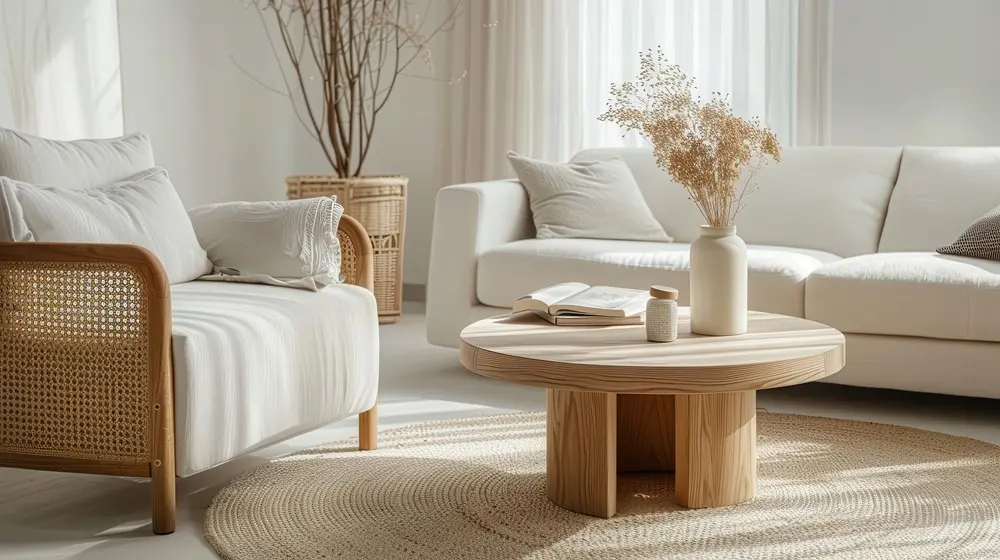
Japandi style—where Japanese minimalism meets Scandinavian warmth, is fast becoming the design language of modern, serene living spaces. Defined by natural materials, clean lines, and thoughtful simplicity, this aesthetic celebrates balance and functionality without sacrificing beauty. At the heart of the Japandi living room lies a quiet yet powerful piece: the coffee table.
More than just a spot to place your drink, a Japandi coffee table anchors the room. Crafted often from solid wood like oak or walnut and featuring low, streamlined silhouettes, these tables reflect a lifestyle rooted in intentional living. Whether in a cozy condo or a modern terrace home, the Japandi coffee table introduces both form and function to your space. Discover how to choose the perfect Japandi coffee table, style it for everyday use, and avoid common mistakes.
Why Japandi Coffee Tables Are the Centerpiece of Calm Living
Japandi style seamlessly blends the refined elegance of Japanese design with the soft minimalism of Scandinavian interiors. Together, they prioritize harmony, craftsmanship, and a strong connection to nature—values deeply reflected in the humble coffee table.
In a Japandi-inspired living room, the coffee table becomes more than a furnishing; it becomes a visual and functional anchor. Its low height encourages a grounded, relaxed way of living, echoing traditional Japanese floor seating culture. Common features include clean lines, open silhouettes, and subtle storage which support a lifestyle of intentional simplicity. Crafted primarily from wood with neutral finishes, Japandi tables carry an understated warmth and a tactile beauty.
How to Choose the Perfect Japandi Coffee Table
Prioritize Low-Profile, Streamlined Shapes
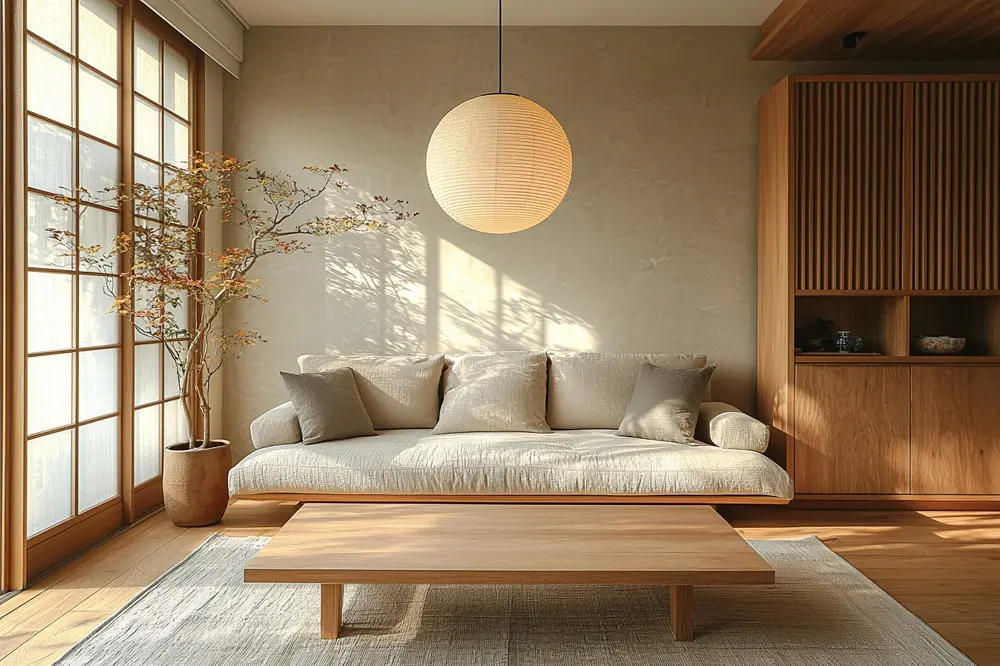
Japandi interiors avoid the grand or the flashy. Instead, go for low-set, simple silhouettes that mirror Japanese floor seating traditions and Scandinavian clean lines. A well-chosen coffee table should blend into the room while quietly enhancing its balance.
Focus on Natural Materials like Wood and Rattan
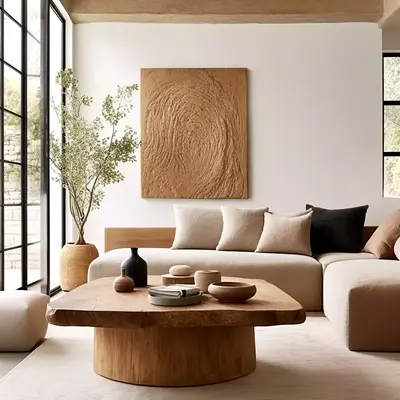
Wood is the foundation of Japandi design. Look for sustainably sourced hardwoods like oak, ash, or walnut for durability and warmth. Rattan can also introduce lightness and an earthy texture, perfect for Japandi interiors in tropical climates or compact apartments. Choose matte or raw finishes over glossy ones to retain a natural, unpolished charm.
Design with Purpose: Functional Beauty in Japandi Coffee Tables
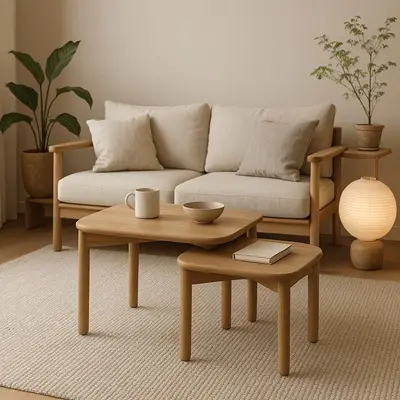
Japandi furniture is all about function that does not compromise form. A well-designed coffee table does not just look good; it enhances how you live. Built-in storage keeps essentials tucked away, softly rounded corners bring both safety and softness, and lightweight materials make daily living more flexible and fluid.
Nesting tables come in a set of two or more, designed to fit neatly underneath one another when not in use. This compact storage makes them an ideal choice for smaller homes or multi-purpose spaces, offering flexibility without adding visual clutter. Tables with slim profiles, right-sized proportions, and breathable bases such as rattan or open wood slats, effortlessly balance comfort with quiet elegance.
Shape with Purpose: Round vs. Square Coffee Tables
The shape of your coffee table can significantly influence both the look and functionality of your living space. Choosing the right form is about more than aesthetics, it is about how the room feels and functions.

In terms of impression, round coffee tables create a soft and organic impression. Their curved lines help break up rigid angles in a room, bringing a sense of flow and ease. This shape gently invites movement and makes the overall space feel more relaxed and open—an ideal fit for the calming nature of Japandi design.
In contrast, square or rectangular coffee tables offer a more grounded, structured look. They introduce visual balance and stability, which is especially helpful in modern or minimalist layouts. The clean geometry of these shapes complements the understated elegance of Japandi interiors, reinforcing a sense of order and intentionality.
In terms of functionality, round coffee tables are especially well-suited to smaller homes or social settings. With no sharp corners, they make it easier to move around, perfect for compact spaces or gatherings where guests are seated from all sides. Their circular shape also fosters a more inclusive and conversational setup, while reducing the risk of bumps or scrapes, a thoughtful choice for family-friendly living rooms.
Square and rectangular tables, meanwhile, excel at defining zones within open-plan layouts. Their shape naturally anchors the seating area and provides ample surface space for displaying curated items or holding everyday necessities, all while maintaining a clean and purposeful appearance.
8 Japandi Coffee Table Styling Ideas for Everyday Inspiration
In Japandi interiors, the coffee table presents an opportunity to tell a quiet story. Every item, texture, and material should feel intentional and connected to the room's overall calm. These 8 styling ideas will help you bring out the serene beauty of your coffee table while staying true to Japandi principles.
1. Soft Wood Tones Paired with Light Rugs
Combine light-toned woods with pale, woven rugs to reflect light and bring warmth without overwhelming the space. Underneath, a pale, woven cotton or wool rug in a soft beige or grey can anchor the table visually and make your living room feel brighter and more spacious. This pairing is particularly effective in smaller homes such as Singapore HDB flats or compact condominiums, where maximizing light and visual airiness is key to creating a tranquil atmosphere.
2. Neutral Ceramic Accents for Soft Texture
Ceramics hold a special place in both Japanese and Scandinavian design traditions, prized for their handmade imperfection and tactile beauty. Adorn your table with small ceramic vases, trays, or bowls in neutral tones like ivory, taupe, or clay. These pieces bring subtle texture to the tabletop while staying within the understated Japandi palette. Whether you use them to hold dried flowers, display incense, or simply as sculptural forms, they add softness without creating visual noise.
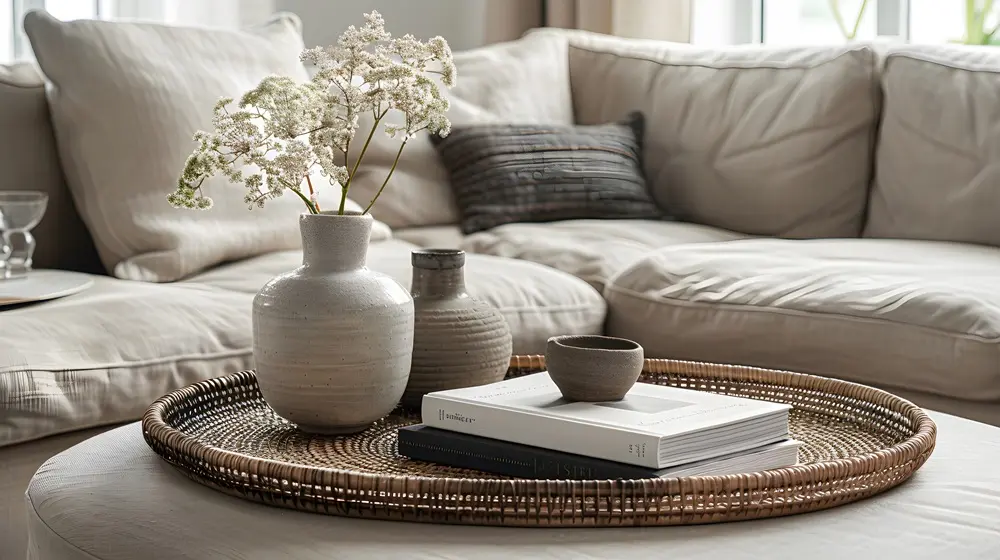
3. Curated Tabletop: Books, Trivet, and Calm
Less is always more, resist the urge to fill your coffee table with too many objects. Select one or two meaningful items to create a calm, curated surface. A linen-bound book, a hand-carved wooden trivet, and a small potted plant or seasonal greenery can say more than a dozen decorative pieces. The trivet, traditionally used for serving tea or hot dishes, doubles as an aesthetic element, reinforcing the Japandi value of functional beauty. Leave generous negative space, it is part of the design, inviting rest for both the eyes and the mind.
4. Black Accents for Contrast and Balance
While Japandi interiors are known for their softness and lightness, a touch of black can add just the right amount of contrast. Matte black trays, sculptural candle holders, or minimalist ceramic objects can create visual tension that feels balanced rather than harsh. These accents help ground the space and prevent it from feeling too monochromatic or washed out. Use them sparingly but intentionally, just one black piece on the table may be enough to make a refined statement.
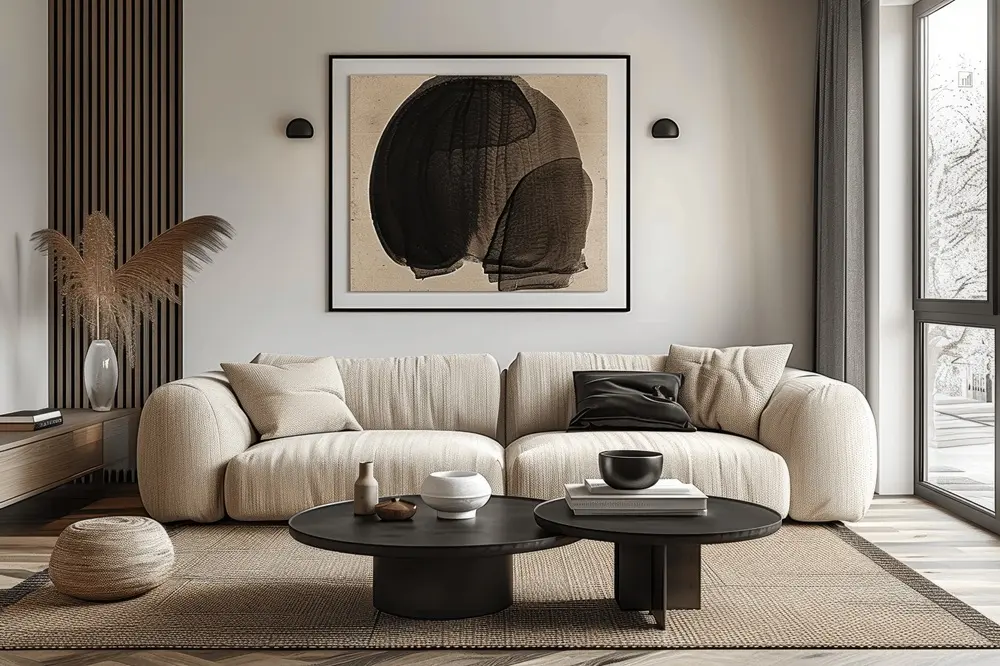
5. Japandi-Style Trays to Decorate & Declutter
Trays are a Japandi essential—not just for organizing daily items, but for enhancing the sense of intentionality in your styling. Select trays made from wood, rattan, or ceramics that reflect the natural material palette of the space. Use them to group frequently used objects like remote controls, candles, or teaware, so the table surface remains clean and uncluttered.
6. Beautiful Everyday Teaware as Display
One of the simplest yet most powerful ways to bring Japandi style to your coffee table is to display beautiful, functional teaware. A Japanese cast iron teapot, a set of stoneware cups, or a handcrafted matcha bowl instantly connects your space to quiet ritual and slow living. These items are not just decorative, they invite you to pause, pour a cup of tea, and enjoy the moment. When not in use, they still serve as elegant reminders of the beauty in daily habits.
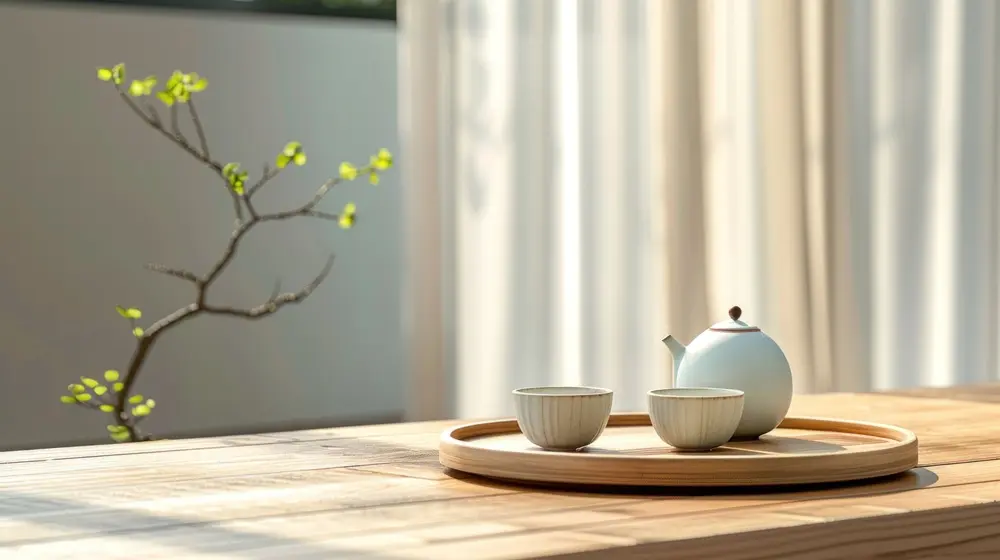
7. Layered Textures with Lighting & Soft Furnishings
Styling your coffee table also involves creating a peaceful environment around it. Layering soft materials in the area enhances visual and tactile warmth while keeping the look cohesive. A linen-upholstered sofa, a cotton floor cushion beside the table, or a pendant lamp with a fabric or rice paper shade can work together to soften the scene.
8. Don's Forget the Side and End Tables
While the coffee table is the focal point, thoughtfully chosen side and end tables can complete the Japandi look. Match wood tones for a cohesive feel, or introduce contrast with a different natural material like stone or woven fiber. Keep the design consistent: opt for pieces with clean lines, open bases, and neutral finishes. When styled in harmony with the coffee table, these accent pieces enhance flow, offer added function, and bring a sense of completeness to the living area.
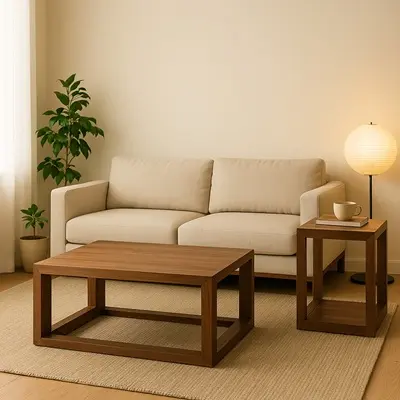
5 Common Mistakes to Avoid When Styling a Japandi Living Room
Even with the best intentions, it can be easy to overlook the subtle details that define a true Japandi space. Avoiding the following common styling mistakes will help you stay true to the essence of Japandi and create a space that feels both grounded and inviting.
1. Choosing Bulky or Glossy Furniture
Oversized coffee tables, thick legs, or bulky frames can quickly dominate the room and disrupt the sense of openness. Similarly, glossy finishes or lacquered surfaces may feel overly flashy or artificial, contrary to the natural textures and modest, quiet impression that define Japandi style.
2. Ignoring Color Harmony with Japandi Aesthetics
Color plays a crucial role in Japandi interiors, acting as a subtle backdrop that brings cohesion and calm. Bright, saturated hues or overly cool tones can feel jarring against Japandi's natural palette. To maintain harmony, stick to warm neutrals like soft beige, ivory, warm greys, clay, and muted browns. Even darker accents, like charcoal or black, should feel soft and grounded rather than stark.
3. Overdecorating the Coffee Table
Resist the urge to crowd the coffee table with decorative objects, turning it into a mini showroom rather than a usable, calming centerpiece. Rather than styling for quantity, choose just two or three purposeful items such as a handcrafted ceramic bowl or a small plant. The quiet spaces between items create visual rest, which is key to Japandi's meditative quality.
4. Lack of Functionality
If your coffee table looks good but does not support your lifestyle, it is missing the point. Avoid styling purely for aesthetics without considering how the space will be used. Can you easily place a cup of tea down? Is there room for your everyday essentials?
5. Clashing Shapes and Heights
Harmony in shape and proportion is just as important as harmony in color and material. Placing items of wildly different heights or mixing too many contrasting shapes on or around your coffee table can create visual dissonance. Avoid pairing tall vases with tiny accessories or combining harsh angles with soft curves without intention.
Bonus Section: How to Enjoy Japandi Coffee Tables Outdoors
Japandi design's natural materials, simple forms, and emphasis on calm living make it a perfect fit for outdoor settings. Whether you are styling a compact balcony, a garden patio, or a breezy rooftop corner, you can carry the Japandi philosophy outside by choosing the right coffee table and complementary elements.
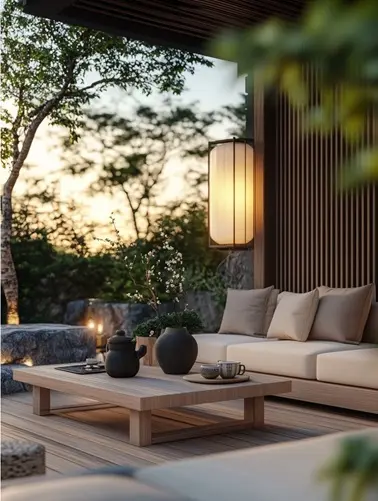
Choose Weather-Resistant Japandi-Inspired Materials
Durability matters outdoors but it does not mean you have to sacrifice style. Look for Japandi-inspired tables made from weather-resistant wood like teak, acacia, or eucalyptus. These hardwoods are naturally rich in oils, making them ideal for humid or tropical climates. Powder-coated metal frames in minimalist shapes can also offer a clean, structured look while standing up to the elements.
Stick with the same design principles as your indoor space: clean lines, neutral tones, and organic textures. A teak slatted coffee table or a stone-look ceramic top with wooden legs can maintain visual continuity between your indoor and outdoor areas.
Protect Your Table with Stylish Covers and Shading
To extend the life of your Japandi coffee table, invest in protective coverings that complement the space. UV-resistant parasols, outdoor canvas shades, or bamboo blinds not only shield the furniture from harsh sun and rain, but also add a textural, calming element to the setting.
Consider creating shade in a way that enhances the atmosphere—soft, dappled light filtering through a woven shade can make your outdoor area feel more like an extension of your home. During rainy seasons or long absences, use neutral-toned covers that match the table's color palette to avoid visual disruption when the table is not in use.
Elevate Your Everyday with Japandi Simplicity
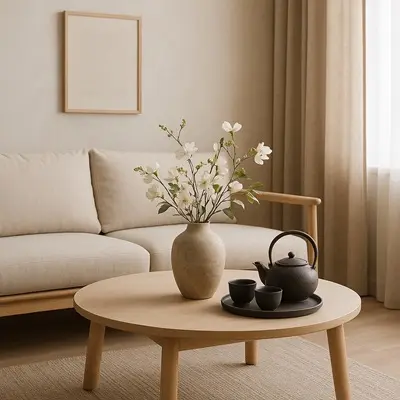
In the Japandi world, a coffee table is never just a coffee table, it is a reflection of your values. With its emphasis on natural materials, thoughtful design, and calm utility, the Japandi coffee table invites you to slow down and be intentional with your space. Whether you are styling a serene indoor retreat or a minimalist patio nook, let your table embody simplicity, elegance, and the quiet joy of everyday living.
*Some of the images featured in this article were created using generative AI.

